Data management is crucial for healthcare organizations aiming to improve performance and patient outcomes. Much healthcare data must be more usable and come from various sources, including electronic health records, patient management systems, and billing software. As a result, patient information often contains errors, duplicates, and inconsistencies. For instance, when patients visit the hospital, they may have a file different from the one at their doctor’s office. If their data isn’t merged, while both files may have similar information (such as their name and date of birth), one will likely contain out-of-date details.
This could negatively impact the patient’s care. A master data management solution can help healthcare organizations avoid this scenario by streamlining data processes and improving data quality and accessibility. This guide will explore MDM solutions, including their benefits, how they work, and how healthcare organizations can implement them.
Azulity’s healthcare data management services can help you reach your goals and allow your organization to improve patient outcomes through better data management. Our solutions enable and focus on your organization’s needs to ensure a smooth and valuable experience.
What Is A Master Data Management Solution

Master data management (MDM) is a process that creates a uniform set of data on customers, products, suppliers, and other business entities across different IT systems. One of the core disciplines in the overall data management process, MDM helps improve the quality of an organization’s data by ensuring that identifiers and other key data elements about those entities are accurate and consistent enterprise-wide.
When done correctly, MDM can also streamline data sharing between different business systems and facilitate data processing in IT environments that contain a variety of platforms and applications. In addition, effective master data management helps make the data used in business intelligence (BI) and analytics applications more trustworthy.
Master data management grew out of previously separate methodologies focused on consolidating data for specific entities, particularly customer data integration (CDI) and product information management (PIM). MDM combined them into a single category with a broader focus, although CDI and PIM are still active subcategories.
The types of master data vary depending on the type of organization, but they all share some similar qualities:
Less Volatile
Master data tends to change less frequently than other data, but it does change. Data sets that never change are rarely classified as master data.
More Complex
Master data usually includes large, complex data sets with multiple variables instead of simpler entities that could be merely tallied or counted. Master data requires processes to keep information up-to-date and accurate.
Valuable or Mission-Critical
Master data is essential to an organization’s day-to-day operations and analytical decision-making. It is used and reused repeatedly.
Non-Transactional
Master data does not usually include transactional data. However, master data can be part of the transaction process, such as data describing the customer, product, or point of purchase.
Importance of Master Data Management Solution In Healthcare


Why MDM Solutions Are Critical for Healthcare Organizations
Healthcare organizations generate massive volumes of data for patient care, billing, operations, and regulatory compliance. Master Data Management (MDM) solutions help healthcare organizations create a single, accurate, consistent view of their data to improve clinical and operational outcomes.
Healthcare operations depend on transaction processing systems, and business intelligence and analytics increasingly drive clinical decision-making, regulatory compliance, revenue cycle management, supply chain operations, and other business processes. However, many healthcare organizations have data that differs from one system to another. For example, patient records might be different in the electronic health record, billing applications, and patient portals due to variations in names, addresses, and other attributes.
Master Data Management (MDM) is an information management solution that combines data into one centralized source of truth. It eliminates data silos so that the right people can access the correct data at the right time.
MDM Solutions Improve Patient Care
Inpatient care and timely access to data can be critical. For example, an unconscious patient arrives at an ER. How quickly can responding providers download their history, medical conditions, allergies, and other pertinent information? Seconds may mean the difference between life and death. And if there are gaps in the data, there will be gaps in the care provided.
MDM Solutions Improve Healthcare Operations
On the administrative side, patient data errors or inaccuracies can lead to billing mistakes. In an industry that follows each patient through all stages of the healthcare organization, inaccuracies can leave a poor impression. In healthcare, data is commonly organized into three domains: patient, provider, and location. Every health system needs to think about how to manage and cleanse that data so it is ready for use across numerous systems and applications. For example, an organization can have financial and clinical systems that use the same data, which is managed or updated once and pushed into those systems.
Consistent, accurate patient data gives organizations greater confidence in providing consistent care. Patient data errors can lead to care mistakes, such as delivering the wrong medication to a patient, or administrative issues, such as billing problems. Ultimately, MDM leads to more efficient and effective data processes by reducing redundant data effort and ensuring accurate data. To achieve these objectives, healthcare organizations use MDM solutions from vendors such as Informatica and IBM to organize, de-duplicate, and cleanse data from different sources. MDM solutions generally include data quality tools, movement, and organization tools.
The Challenges of Implementing MDM Solutions
However, organizations can face challenges as they engage in MDM. Over time, it takes a coordinated effort from multiple people and departments as stakeholders identify and collect master data. Getting assistance from a trusted, experienced third party often helps organizations achieve their MDM objectives. These experts can also help an organization implement data governance best practices and apply them to master data. It’s also helpful to establish roles for data quality managers and analysts who can understand and apply knowledge on data quality to critical domains.
Healthcare organizations that implement MDM practices effectively will be on solid ground as they engage in digital transformation initiatives that use data from various sources.
Real-World Examples of MDM in Healthcare
Mayo Clinic uses MDM to manage patient and operational data, improving data accuracy and ensuring all departments have a consistent view of critical information. McKesson Corporation implements MDM for supply chain management and patient data accuracy, focusing on data quality and operational efficiency across their vast network. Cleveland Clinic employs MDM to streamline patient records and operational data across its network of hospitals and clinics, ensuring data consistency and improving care delivery.
Azulity: Your Experts in Healthcare Master Data Management
Azulity specializes in healthcare master data management, bringing proven expertise in implementing healthcare data solutions and credentialing across the US. Our comprehensive platform ensures consistent patient, provider, location, and claims data synchronization across all systems and departments. Key features include healthcare MDM, provider MDM, reference data management, credentialing, and provider enrollment. We serve healthcare technology leaders – from CIOs and CDOs to VPs of data platforms and credentialing – helping them eliminate the costly problems of fragmented data systems. Book a call to learn more about our healthcare master data management services today!
Related Reading
16 Best Master Data Management Solutions for Healthcare Industry


1. Azulity


Azulity focuses on master data management in healthcare, helping organizations manage the complexities of data in this highly regulated industry. The platform helps to synchronize patient, provider, location and claims data across disparate systems and departments. Key features include healthcare MDM, provider MDM, reference data management, credentialing, and provider enrollment. Azulity aims to help healthcare organizations eliminate the costly problems of fragmented data systems.
2. Ataccama ONE
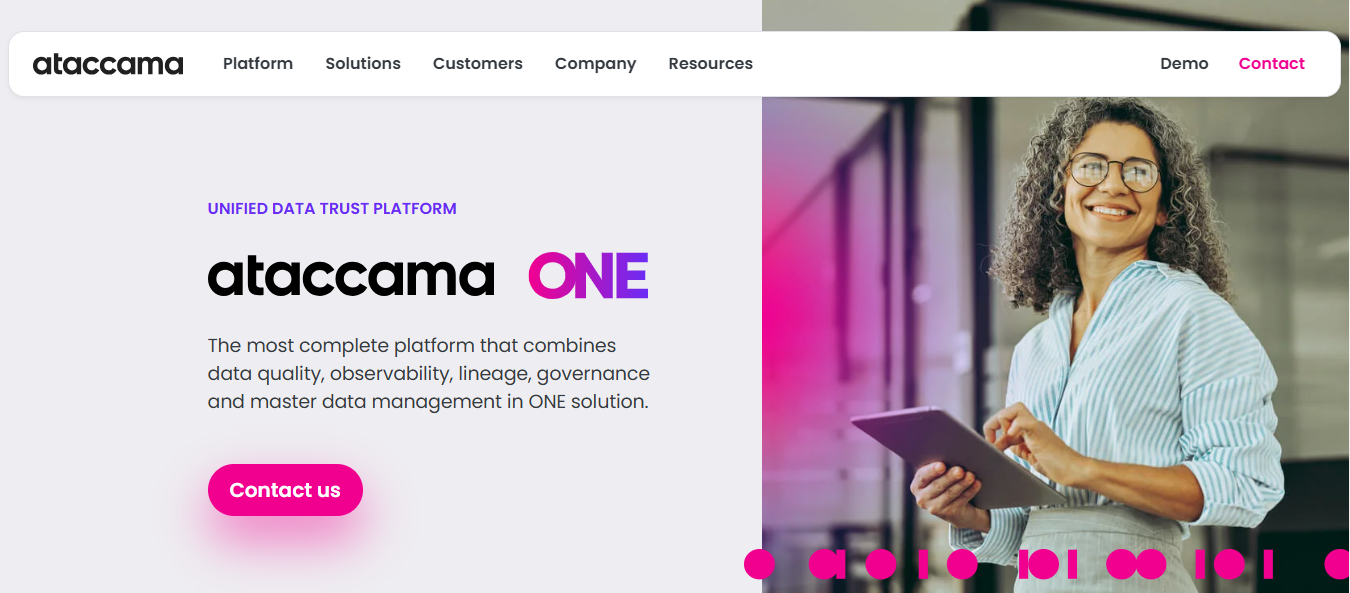

Ataccama ONE has a collaborative data curation platform that includes data profiling and cataloging solutions, data governance and quality, and master data management. Its MDM solution supports multiple domains, reference data management, hierarchy management, and more.
Pros
Supports multi-domain MDM Offers robust data matching, identity management and hierarchy management capabilities Delivers a highly scalable solution Supports big data connectivity and complete data quality activities
Cons
Less developed product information management capabilities compared to other MDM solutions Requires a separate module to support reference data management Relatively small player in the MDM market Lengthy implementation and deployment process
3. SAP
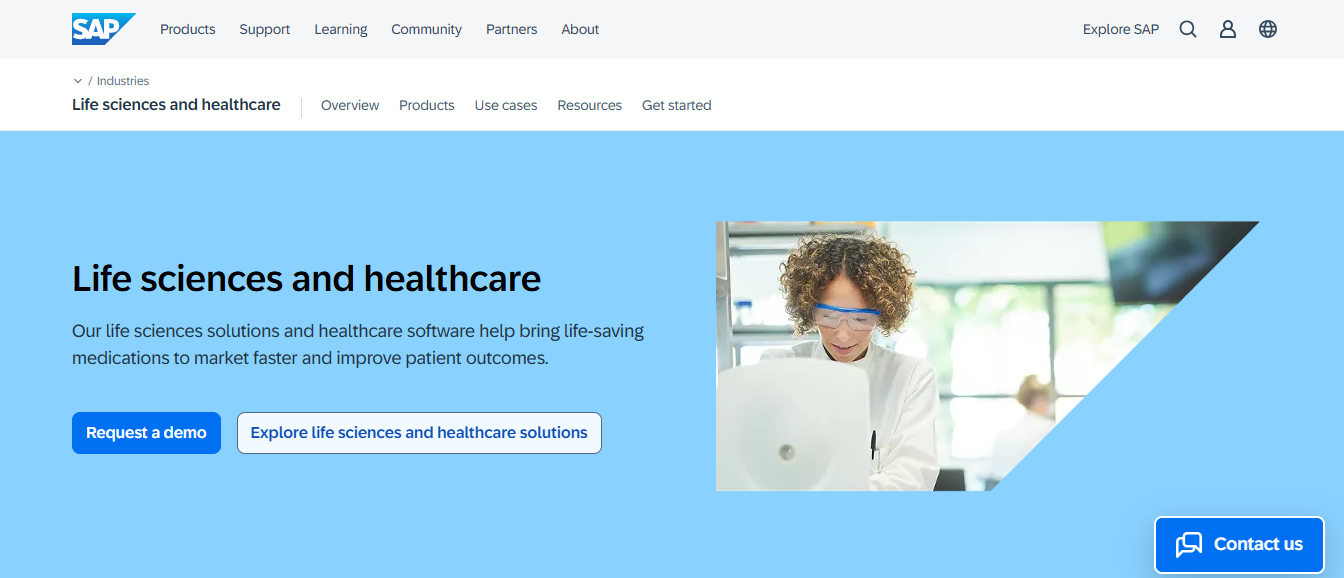

SAP Master Data Governance is an MDM platform that obtains master data that users can view, manage, and share in a unified solution. Its data management capabilities are based on its proprietary SAP Business Technology Platform. Features of SAP Master Data Governance that caught my eye were its ability to enhance the development of data quality rules and synchronization of master data. You can use its machine learning feature to improve your data quality rules and easily sync your master data across solutions.
Pros
Task automation capabilities for managing master data Machine learning features to enhance the development of data-quality rules Merge master data from SAP software and third-party sources.
Cons
The platform lacks mobility support Lacks online documentation for certain features
4. Pimcore Open Source Master Data Management
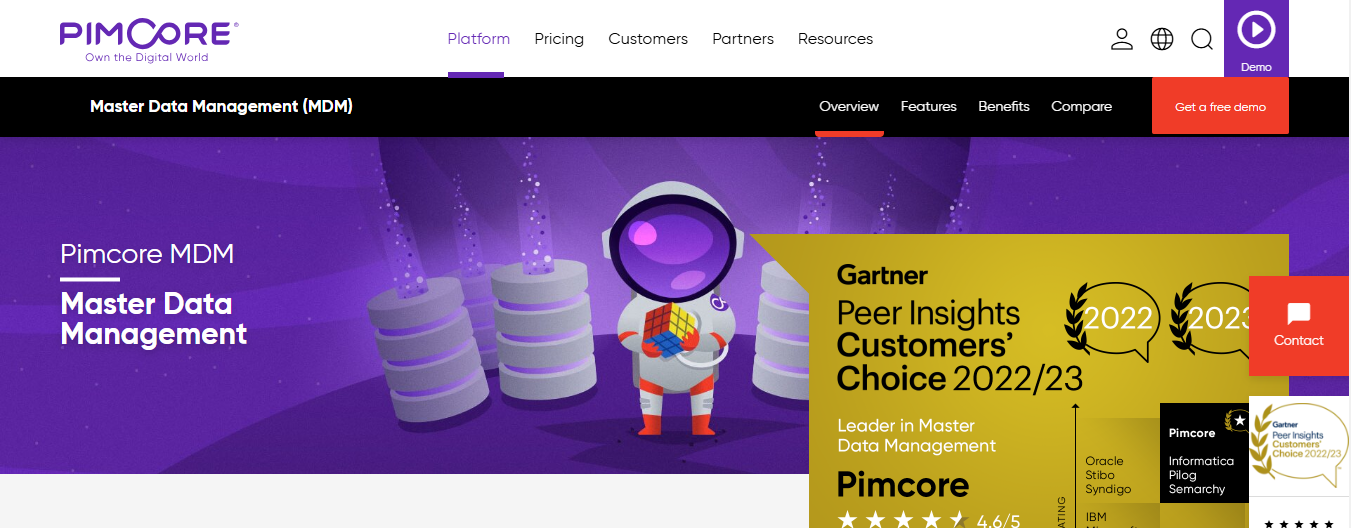

Pimcore Open Source Master Data Management provides users with a robust workflow management system to simplify handling data quality issues. It also allows users to readily model complex hierarchies to classify and use data in business intelligence. Features of Pimcore Open Source Master Data Management that caught my eye included its powerful workflow management engine. This features a workflow designer for business processes with custom states and actions, as well as messaging and notifications. These capabilities make it easier for stakeholders to understand and adapt to changing business processes.
Pros
Access to historical views for improved data governance. Use various dataset formats to match industry standards. Easily define cleansing rules for creating golden records.
Cons
Documentation for developers needs improvement. System installation can be complex and tedious
5. Boomi Master Data Hub, a Dell Technologies Business


Dell Boomi is a built-in-the-cloud MDM solution that offers capabilities around application integration, master data management, and domain-specific data quality. Boomi’s multi-tenant platform supports cloud-to-cloud, cloud-to-on-premise, and on-premise-to-on-premise integrations, including real-time integrations, and it scales elastically to support volume increases.
Pros
It supports MDM capabilities, such as bidirectional data flows, enrichment, and multi-domain support. It offers MDM, data integration, and API management in a single solution. It includes an analytics-based control console. It provides access to an entirely cloud-based solution that integrates easily with cloud and on-premise applications.
Cons
Reference data management capabilities are less fully developed than in many other MDM solutions. Limited product information management capabilities Steep learning curve for users Poor debugging capabilities
6. Oracle Enterprise Data Management


Oracle Enterprise Data Management is a robust MDM tool that allows users to use accurate master data to adapt and respond to change efficiently. You can effectively manage your enterprise data—whether you need to reconcile company metadata, make cloud transfers, or manage mergers. The features of Oracle Enterprise Data Management that stood out to me were its ability to validate master data and to co-author quickly in real time. Confirming data nodes and hierarchies immediately can help decision-making, while its co-authoring feature allows departments or business units to collaborate effectively.
Pros
Improve data quality by validating viewpoints. Monitor ongoing concerns using conversation threads. Easily connect business apps using dedicated and universal adapters.
Cons
The user interface can be challenging to understand. It requires in-depth training to be used effectively.
7. Semarchy xDM
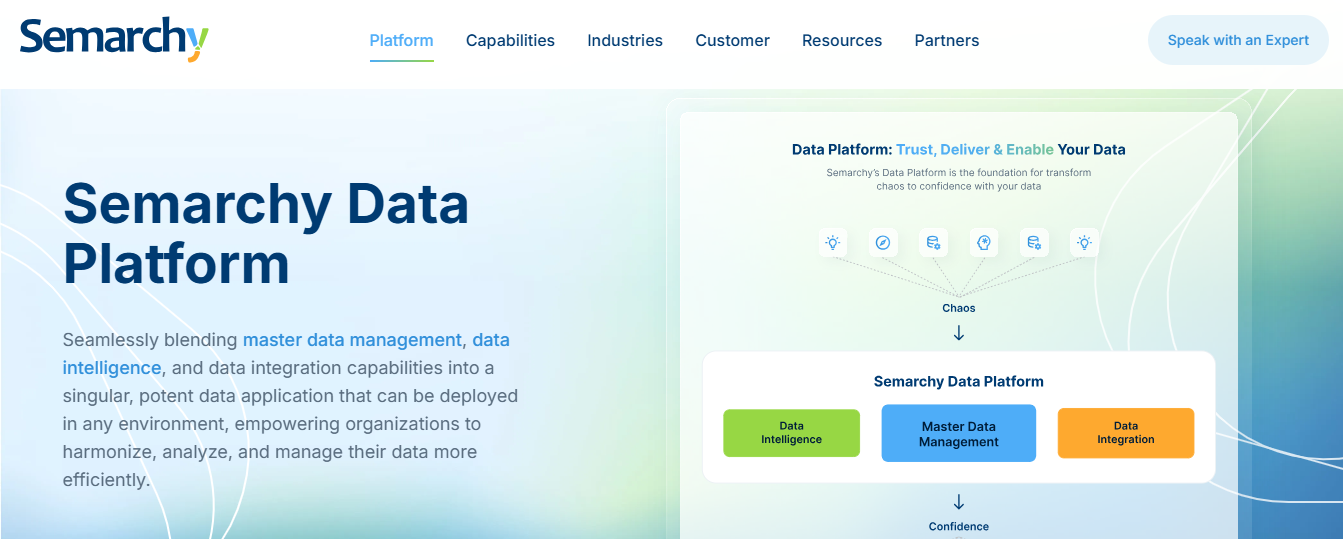

Semarchy xDM is a zero-code MDM platform that helps data teams analyze source data using an advanced match/merge and consolidation engine. The tool lets you collaborate with colleagues in managing, governing, and accessing comprehensive data models. Features of Semarchy xDM that I liked were its automations, open architecture, and flexibility. This MDM tool lets you create custom rules while ensuring your golden records are accurate. Meanwhile, I learned that its agnostic architecture is quite flexible, allowing you to use almost any API or service with the platform.
Pros
The platform can scale based on your needs. No coding is necessary for designing business apps. Access powerful automations for creating custom rules
Cons
Has a steep learning curve. Some advanced functions can be complicated to locate
8. Tibco EBX


TIBCO EBX is a data management system that allows organizations to share their master data via a single platform. It follows a unique design approach that combines various features for managing and customizing datasets according to your needs. TIBCO EBX’s features that stood out to me were its data modeling and governance. The data modeling feature lets you model data using specific rules to meet your requirements. I also found its data governance capabilities effective for centralized control of common artifacts and governance processes.
Pros
It provides built-in data importation features for XML and CSV formats. Users can integrate the graphical interface into almost any application. Customizable data and workflow modeling
Cons
No free trial Interface may not provide the best user experience
9. IBI (Information Builders) Data & Analytics
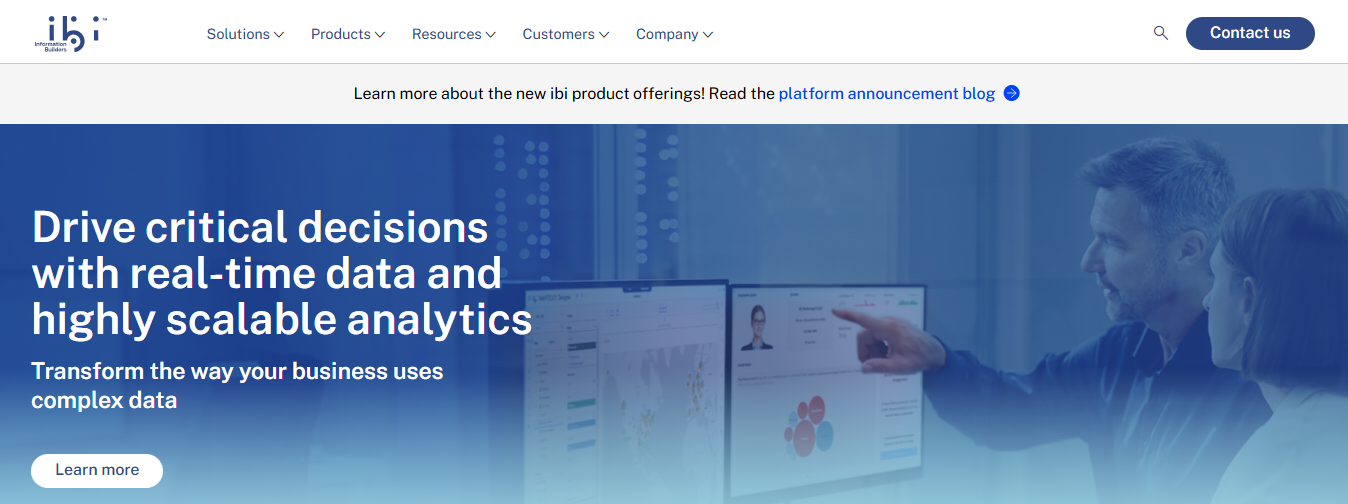

IBI (Information Builders) offers an integrated platform for business intelligence (BI), analytics, data integration and data quality. Its data platform includes data preparation, integration, quality, management, and governance capabilities.
Pros
Features an easy-to-use UI for core capabilities Boasts a substantial variety of customer references and reviews Provides access to extended capabilities, particularly around BI and analytics through other solutions from Information Builders Includes design tools to represent both golden records and source records. visually
Cons
Poor documentation and training for non-core capabilities Minimal relationships with major systems integrators Limited visibility into product roadmap Room for improvement with monitoring and error notifications
10. Enterworks


EnterWorks by Precisely is an MDM tool that enables enterprises to connect their databases and applications to create golden records. The platform boasts a low-code design and can improve revenue growth through accurate product intelligence. Features of EnterWorks that caught my eye were its Product Information Management (PIM) and Digital Asset Management (DAM) modules. These capabilities make the platform an ideal hub for analyzing product intelligence and creating customer-centric products.
Pros
Access to in-depth product information. The low-code design allows users to adapt quickly—easy access to tools and data that drive revenue.
Cons
No free trial Can throw up errors in some jobs
11. IBM InfoSphere Master Data Management
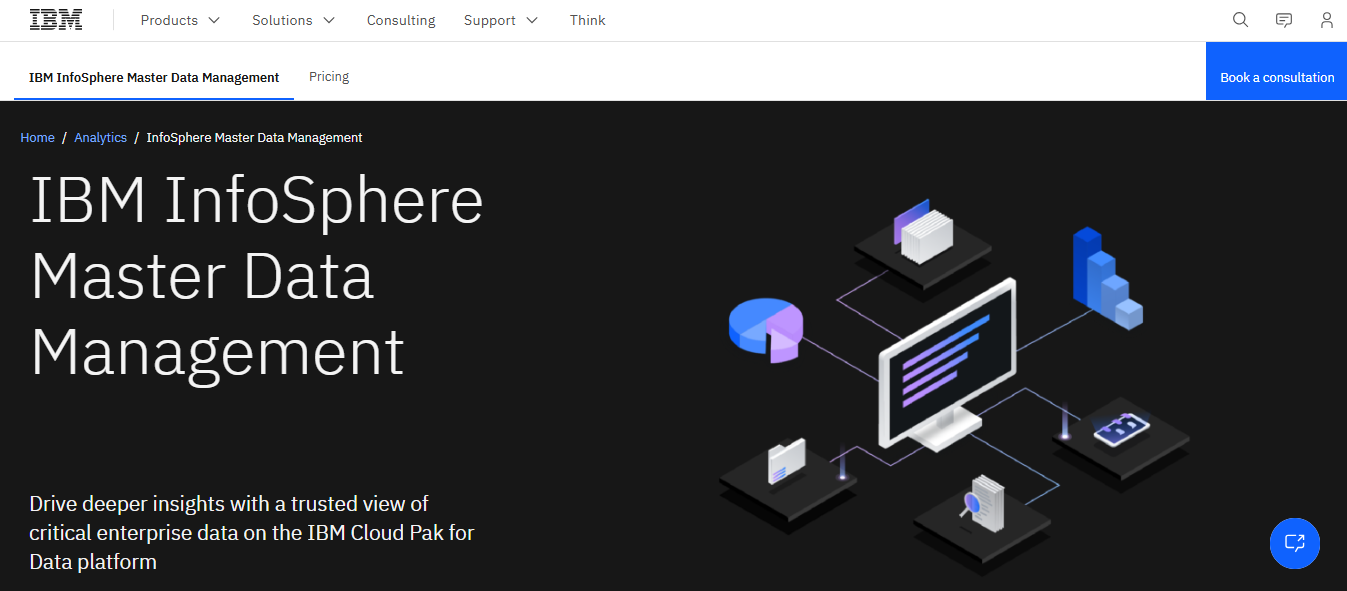

IBM InfoSphere Master Data Management is a multi-domain enterprise MDM solution that includes access to IBM’s data governance and orchestration offerings. It offers a highly configurable framework with capabilities for various business users and data analytics.
Pros
Supports multi-domain MDM. Offers multiple deployment options, including on-premise and cloud. Delivers robust support for big data governance and reference data management. Provides a scalable solution with proven performance, especially around data matching
Cons
A relatively complex solution typically requires a sizeable technical footprint, making implementations lengthy. User licensing can also get complicated and quickly become expensive, requiring frequent updates.
12. Syniti Master Data Management
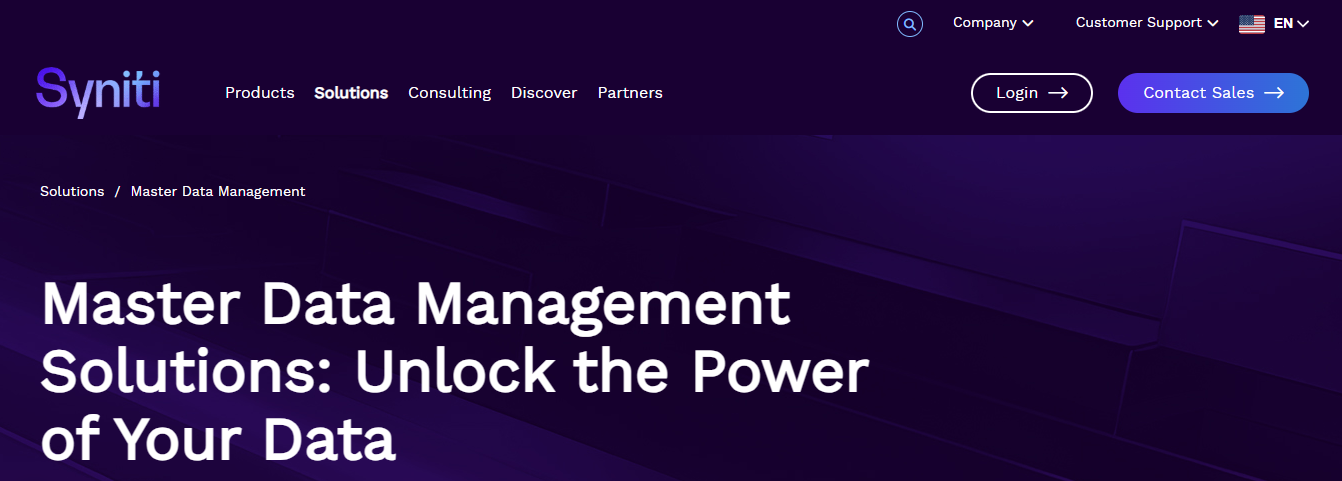

Syniti Master Data Management is another MDM tool that connects organizations to master data with a financial impact. Businesses that use the platform can expect to improve outcomes through faster master data management processes and practical user collaboration tools. Features of Syniti Master Data Management that captured my attention were its ability to link clean master data to a company’s KPI improvements and help them provide value faster. The platform readily connects data improvements for quicker MDM returns while assisting users to identify financial upsides immediately.
Pros
Install Knowledge Packs to improve your MDM process. Knowledge packs are scalable with any business process, system, or data type. Acquire clean master data and track KPI improvements.
Cons
It can be difficult for beginners to learn Information from logs, but they could provide more details.
13. Informatica MDM


Informatica is an enterprise cloud data management provider with various solutions designed to help organizations manage their data and put it to work. Informatica has several MDM solutions that provide multiple domain MDM capabilities and can be deployed in the cloud or on-premise.
Pros
Supports multi-domain MDM. Offers multiple deployment options, including on-premise and cloud. Delivers robust support for big data governance and reference data management. Provides a scalable solution with proven performance, especially around data matching
Cons
A relatively complex solution typically requires a sizeable technical footprint, making implementations lengthy. User licensing can get complicated and quickly become expensive, requiring frequent updates.
14. Profisee


Profisee provides organizations an MDM tool for improving data quality through an intuitive user interface. Its UI employs machine learning, assisting users with detecting issues and cleansing master data from a single source. The features of Profisee that I found most interesting were its data visualization and modern UI. Both capabilities allow the platform to provide a singular view of data from different sources so users can address discrepancies immediately.
Pros
The platform can scale depending on need. Its user-friendly interface allows for fast deployment. It can also quickly identify and cleanse discrepancies in master data.
Cons
Customer support needs improvement. Performance for data insertion tasks could be better.
15. Magnitude Kalido MDM
Magnitude Kalido MDM is a multi-domain MDM solution that supports data modeling and policy-driven data governance. It also offers several interfaces for unique audiences and different views for various roles.
Pros
Offers reference data management, hierarchy management, centralized authoring, and data harmonization in a single solution. Supports multi-entity MDM and deployments across multiple domains. Allows for unique user interfaces for different roles, all without any coding. Features robust visual modeling capabilities.
Cons
Minimal relationships with significant system integrators Limited customer references and reviews Magnitude’s history of and continued focus on acquisitions can lead to poorly integrated solution developments (versus natively developing new capabilities) Less developed information governance support than many other MDM solutions.
16. Reltio
Reltio is a cloud-based, multi-domain MDM solution that supports structured and unstructured data and offers a scalable solution for smaller organizations and enterprises.
Pros
It supports multi-domain MDM and allows for collaborative data stewardship, rating, and segmentation. It also features native data visualization, analytics, and search functionality.
Cons
A relatively new player in the MDM space with a still-evolving platform Generally requires extensive customization that must be performed by a partner Limited customer references and reviews Minimal implementation support and documentation Limited user documentation.
Problems Master Data Management Solutions Solve


Say Goodbye to Healthcare Data Silos
Data silos plague healthcare organizations, leading to fragmented and inconsistent information that affects patient care. Different departments can’t access the same information when patient data is scattered across multiple systems, such as EMRs, billing software, and lab technologies. This data fragmentation can delay care and lead to costly medical errors. Master data management solutions eliminate healthcare data silos by creating a centralized repository for critical information. The technology extracts, cleans, and consolidates data from disparate sources to create a single, accurate, unified view of essential healthcare information.
Eliminate Duplicate Patient Records
Duplicate patient records are a significant problem for healthcare organizations that can lead to dangerous medical errors. When a patient has multiple files in a provider’s database, clinicians may inadvertently reference the wrong chart during a patient’s visit. This can happen when the records contain different information due to a recent change in the patient’s medical history, and the clinician is unaware that there are duplicate files. The only way to eliminate the risk of this dangerous scenario is to ensure each patient has a single, accurate electronic record. Master data management solutions help healthcare organizations achieve this goal by identifying and merging duplicate files.
Improve Regulatory Compliance and Reporting
Healthcare organizations must comply with many regulations governing patient data security and privacy, such as HIPAA and GDPR. Failing to meet these requirements can result in hefty fines and penalties that cripple an organization financially. Master data management solutions improve regulatory compliance and reporting by establishing a solid framework for healthcare data governance. The technology helps organizations gain control over their information by facilitating accurate and timely reporting of critical metrics to the proper regulatory agencies.
Streamline Healthcare Operations
Inefficient data management can cripple healthcare operations, delaying access to vital patient information and hindering decision-making. Master data management solutions improve operational efficiencies by creating accurate and consistent data that healthcare providers can rely on to make timely decisions. This helps reduce redundancies and lowers operational costs by minimizing administrative errors.
Standardize Provider and Facility Data
Keeping provider and facility data updated in large healthcare networks is a monumental task. This challenge affects everything from patient referrals to insurance claims processing. Master data management solutions create standardized, accurate provider and facility data across systems, enhancing referral accuracy, claims processing, and improving patient experience.
Enhance Patient Experience and Care Coordination
Disparate data systems can lead to gaps in patient care, such as missed lab results, duplicated tests, and confusion over patient history. Master data management solutions provide a comprehensive view of the patient’s journey, enhancing care coordination among providers and improving patient experience by reducing redundancies and errors.
Improve Data Analytics and Population Health Management
Fragmented data limits a healthcare organization’s ability to conduct robust analytics, essential for population health management, risk stratification, and personalized medicine. Master data management solutions provide clean, consolidated data for accurate analysis, enabling healthcare providers to gain actionable insights, track population health trends, and develop personalized care strategies.
How To Implement Master Data Management In Healthcare


1. Use Azulity: The Pros of Master Data Management in Healthcare
Azulity focuses on healthcare master data management. Our proven healthcare data solutions help organizations eliminate the costly problems of fragmented data systems. Our comprehensive platform ensures consistent patient, provider, location, and claims data synchronization across all systems and departments. Key features include healthcare MDM, provider MDM, reference data management, credentialing, and provider enrollment. We help healthcare technology leaders – from CIOs and CDOs to VPs of data platforms and credentialing – get the most out of their data. Schedule a call today to learn more about our healthcare master data management services.
2. Define Your Objectives: Get Specific About MDM in Healthcare
Next, identify your objectives for implementing Master Data Management in healthcare. What specific data challenges do you want to address? Improving data quality? Enhancing data integration? Streamlining data governance? Understanding your goals will help you establish a clear vision and direction for your Master Data Management initiative.
3. Assess Your Current State: Know Where You Stand
Conduct a thorough assessment of your existing data management practices and systems. Identify data sources, data quality issues, data silos, and any inefficiencies in data processes. Assess the maturity level of your data management capabilities to understand the gaps that need to be addressed with Master Data Management.
4. Establish Data Governance: Create Policies and Procedures for MDM
Data governance is a critical component of MDM in healthcare. Define data governance policies, procedures, and frameworks that align with your organization’s goals and regulatory requirements. Establish data stewardship roles and responsibilities to ensure data quality, privacy, and security accountability.
5. Identify Data Domains: Target Key Areas to Standardize
Identify the key data domains critical for your healthcare organization, such as patient, provider, medication, or facility data. Determine the attributes and relationships within each data domain that require standardization and integration. This will help you focus your efforts and prioritize your MDM implementation.
6. Select an MDM Solution: Choose the Right Technology for Healthcare
Choose an MDM solution that suits your healthcare organization’s needs and requirements. Evaluate vendors and solutions based on data integration capabilities, quality management features, scalability, security, and interoperability. Ensure that the chosen solution aligns with your long-term data management strategy.
7. Develop a Data Model: Build the Framework for Your MDM System
Design a comprehensive data model representing your data domains’ structure, attributes, and relationships. Define the data elements and their definitions, hierarchies, and validation rules. The data model will be the foundation for effectively managing and governing your master data.
8. Implement Data Integration: Make Sure Your Systems Can Talk to Each Other
Establish data integration processes to consolidate and integrate data from various systems and sources. Implement data integration technologies and tools that enable smooth data exchange and synchronization. Ensure that data is accurately mapped, transformed, and loaded into the master data repository.
9. Cleanse and Validate Data: Prepare Your Data for MDM
Cleanse and validate your data to ensure its accuracy, completeness, and consistency. Implement data quality processes and tools to identify and resolve issues, such as duplicate records, missing values, or inconsistent formats. Regularly monitor and maintain data quality to sustain high-quality master data.
10. Establish Data Stewardship: Assign Ownership of Master Data
Appoint data stewards who will take ownership of the master data within specific domains. Data stewards will monitor data quality, resolve issues, and enforce data governance policies. Provide them with the necessary training and tools to perform their roles effectively.
11. Monitor and Continuously Improve: Don’t Let Your MDM System Get Stale
Implement monitoring mechanisms to track the performance of your MDM solution and the quality of your master data. Continuously measure and analyze data metrics, such as accuracy, completeness, and timeliness. Use these insights to identify areas for improvement and refine your MDM processes over time.
12. Foster Collaboration: Get Everyone on the Same Page for MDM
Encourage collaboration and communication among stakeholders involved in Master Data Management, including data stewards, IT teams, business users, and executives. Establish cross-functional teams and regular meetings to discuss data-related challenges, share best practices, and align Master Data Management initiatives with business goals.
13. Evolve with Changing Needs: Stay Agile to Respond to New Challenges
Recognize that Master Data Management in healthcare is an ongoing journey. Stay abreast of industry trends, evolving regulations, and technological advancements. Continually adapt and enhance your MDM strategy to meet the changing needs of your healthcare organization and the changing data landscape.
Related Reading
- Healthcare Provider Data Management
- MDM Implementation
- Reference Data Management
- Healthcare Data Integration
- Healthcare IT Consultants
Book a Call to Learn More About Our Healthcare Master Data Management Services
Azulity excels in healthcare master data management. The company understands the healthcare industry’s complex data needs and offers proven solutions for nationwide implementation of healthcare data systems and credentialing. Azulity’s comprehensive MDM platform synchronizes patient, provider, location, and claims data across all systems and departments. Their key features include healthcare MDM, provider MDM, reference data management, credentialing, and provider enrollment. Azulity serves healthcare technology leaders—from CIOs and CDOs to VPs of data platforms and credentialing—helping them eliminate the costly problems of fragmented data systems.
Features of Azulity’s Healthcare Master Data Management System
Azulity’s healthcare master data management system comes with crucial features that help healthcare organizations tackle the challenges of fragmented data. Azulity focuses on synchronizing patient, provider, and claims data across systems for improved operations and performance. Critical features of Azulity’s platform include:
Healthcare Master Data Management
Azulity’s MDM platform helps healthcare organizations create a reliable, centralized repository for all data. This enables consistent, accurate data across systems for improved operational efficiency, reporting, and patient outcomes.
Provider Master Data Management
This feature explicitly targets provider data to reduce inaccuracies, duplicate records, and other data quality issues hindering operations, credentialing, and patient care.
Reference Data Management
Reference data provides context for master data to be correctly understood and utilized. Azulity’s platform helps healthcare organizations manage this data effectively to improve data quality.
Credentialing
Azulity’s platform streamlines the credentialing process for healthcare organizations by improving the accuracy and completeness of provider data, reducing delays and errors.
Provider Enrollment
Accurate provider data also speeds up the enrollment process with payers, reducing payment delays and ensuring a smoother revenue cycle.
How Azulity’s Healthcare Master Data Management System Works
Azulity’s healthcare master data management system works by creating a centralized repository for healthcare organizations to manage their master data. The platform enables organizations to eliminate fragmented data silos by improving the accuracy and completeness of critical data to ensure consistent, reliable information across all systems and departments. The system utilizes advanced data operations, including data governance, quality, and integration, to help healthcare organizations improve operational performance, reporting, regulatory compliance, and patient outcomes.
Benefits of Azulity’s Healthcare Master Data Management System
Implementing Azulity’s healthcare master data management system can help healthcare organizations improve operations and patient care. Some of the benefits of the system include:
Improved Operational Efficiency
The system reduces healthcare organizations’ time managing and correcting inaccurate data. This improves operational performance and allows staff to focus on strategic initiatives.
Better Regulatory Compliance
Accurate data helps healthcare organizations meet regulatory reporting requirements. With the incoming CMS interoperability rules, master data management systems will be essential for healthcare organizations to avoid penalties.
Enhanced Patient Care
Provider and patient data discrepancies can negatively impact care delivery and patient outcomes. Azulity’s platform helps organizations reduce errors and improve data accuracy to ensure smooth care transitions and better patient experiences.
Related Reading
- Healthcare Data Governance
- Healthcare Data Compliance
- Healthcare Data Management Software
- Healthcare Data Architecture
- Healthcare Data Strategy